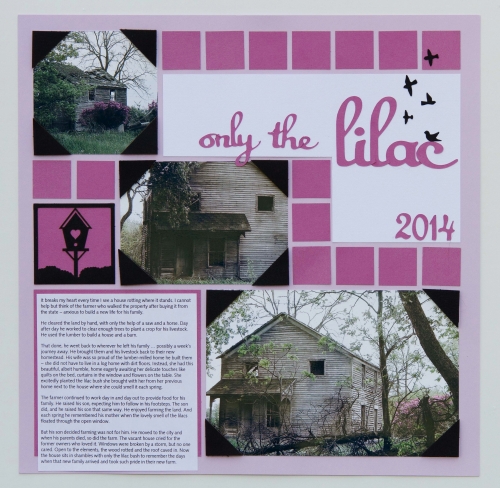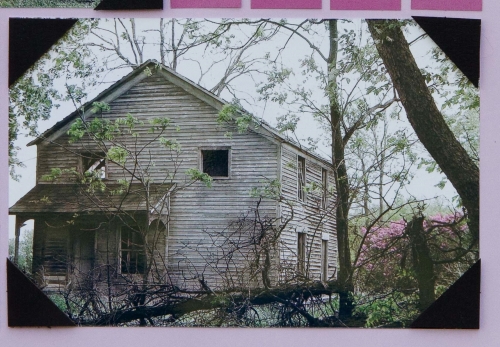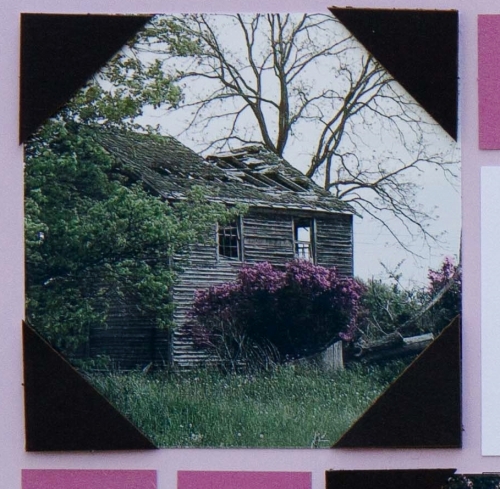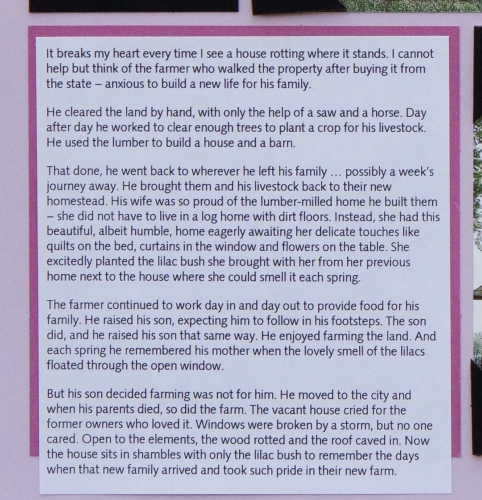
Only the Lilacs

Our challenge this time was to work with black and white photos. We were also asked to use Corner Tiles and Photo Tinting.
It took me awhile to come up with a subject for these photos. I wanted it to be special and I wanted something I could color. Then I remembered an idea I had a few months ago -- to record some dilapidated homes in our area before they tumbled to the ground.
I found this house on Beard Road in the neighboring community of Byron. As I was photographing it, I saw the lilac bush in full bloom and the page just sort of finished itself.
 My camera does not allow me to take black-and-white photos, so I used photo-editing software to remove the color. I decided to leave the green, but take out all of the other color in the photo. Then I printed them out and used a Copic marker to color in the lilacs.
My camera does not allow me to take black-and-white photos, so I used photo-editing software to remove the color. I decided to leave the green, but take out all of the other color in the photo. Then I printed them out and used a Copic marker to color in the lilacs.
I wanted to bring some color to the page to help contrast the lack of color in the photographs so I used Lavender Fields Mosaic Moments Grid Paper and Purple (I'm not sure of the exact color) Paper Tiles.

I added Black Corner Tiles to corners of each of the photos. However, to give it a bit of depth, like looking through a window, I used dimensional foam to adhere each corner. It is hard to see in the photo, but it does add a unique depth in person.
I need a bit more black to help balance out the page, so I added the Birdhouse CornerStone, but I replaced the white background with a colored Paper Tile.
I used my Cricut to cut out the title, added birds cut from a Memory Box die and typed the journaling on the computer.

I let the journaling hang down into the margin of the page.
The journaling is completely made up. I did spend a few hours trying to research the house online, but I was unsuccessful in finding the owners or anything about the house. So, I improvised and shared a story that, I hope, will help you experience the same feeling I have when I see a home or barn abandoned like this.
Here's the text in case you cannot read it in the photo:
It breaks my heart every time I see a house rotting where it stands. I cannot help but think of the farmer who walked the property after buying it from the state – anxious to build a new life for his family.
He cleared the land by hand, with only the help of a saw and a horse. Day after day he worked to clear enough trees to plant a crop for his livestock. He used the lumber to build a house and a barn.
That done, he went back to wherever he left his family … possibly a week’s journey away. He brought them and his livestock back to their new homestead. His wife was so proud of the lumber-milled home he built them – she did not have to live in a log home with dirt floors. Instead, she had this beautiful, albeit humble, home eagerly awaiting her delicate touches like quilts on the bed, curtains in the window and flowers on the table. She excitedly planted the lilac bush she brought with her from her previous home next to the house where she could smell it each spring.
The farmer continued to work day in and day out to provide food for his family. He raised his son, expecting him to follow in his footsteps. The son did, and he raised his son that same way. He enjoyed farming the land. And each spring he remembered his mother when the lovely smell of the lilacs floated through the open window.
But his son decided farming was not for him. He moved to the city and when his parents died, so did the farm. The vacant house cried for the former owners who loved it. Windows were broken by a storm, but no one cared. Open to the elements, the wood rotted and the roof caved in. Now the house sits in shambles with only the lilac bush to remember the days when that new family arrived and took such pride in their new farm.












